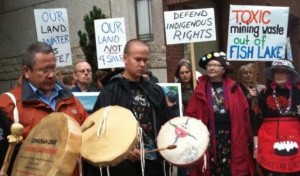Shortly four months after the Supreme Court of Canada gave the Tsilhqot’in First Nation the title of 1,750 square kilometres of land west of Williams Lake, more dispute has risen from the Tsilhqot’in people on the tribal park project.
Covered about 3,120 square kilometres, the tribal park protects cultural, heritage and ecological values, according to the Tsilhqot’in, while connecting to five surrounding provincial parks. The People are claiming that the Taesko’s industrial mining will cause a huge damage on the fish and the fish habitat. Also, large-scale clear-cut logging will destroy the forest that features a unique “rain shadow” forest ecosystem and some of the best habitat for large carnivores in North America. [1]
It is very important for the companies to be aware of their social responsibilities and ethics when they are doing things that have effects on the society. It is also very important to consider what effects a business can have on the local community, such as the social costs and social benefits their actions will bring the community.
In the case of the tribal park project, the interests and opinions of the First Nation should be heard and put into consideration when designing the business model. Also, evaluating the impact of their actions on the environment, society, and Aboriginal culture should take place in the decision-making process.
Watch a video of First Nation Historic victory: https://www.youtube.com/watch?v=z4D85H7lQxE
Source: “Tsilhqot’in set to declare site of New Prosperity mine a tribal park.” www.vancouversun.com. N.p., n.d. Web. 6 Oct. 2014. <http://www.vancouversun.com/news/metro/Unilateral+park+declared+Tsilhqot+includes+Prosperity+mine/10192766/story.html>.
Montpetit, Isabelle. “Background: The Indian Act.” CBCnews. CBC/Radio Canada, 14 July 2011. Web. 5 Oct. 2014. <http://www.cbc.ca/news/canada/background-the-indian-act-1.1056988>.

